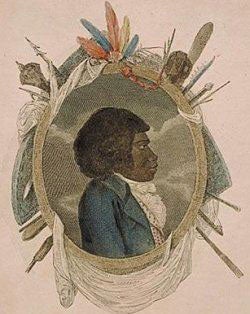Lost Aborigine's secret grave uncovered at last
Burial place of British colonists' first ally found in suburban garden

The grave of Woollarawarre Bennelong, an Aboriginal leader who played a key role in early Australian colonial history, has been discovered in a suburban front garden – solving a 200-year-old mystery.
One of the first Aborigines to interact with British colonists, Bennelong – a senior member of the Wangal tribe – struck up a friendship with the first governor of New South Wales, Arthur Phillip. When Phillip sailed home to England, he took the Wangal man with him, dressed him in Regency finery and introduced him to London high society. When Bennelong returned to Australia, he was ostracised by the indigenous and European communities. In 1813, having sunk into alcoholism, he died – but exactly where he was buried has been the subject of speculation ever since.
Now, after protracted detective work by an environmental scientist, Peter Mitchell, Bennelong's final resting-place has been found, The Sun-Herald newspaper reported yesterday. The discovery represents the missing link in Bennelong's extraordinary story, and is certain to reignite interest in a man who tried to bridge the gap between black and white – a challenge still facing Australians today.
Dr Mitchell, the honourary associate professor of physical geography at Sydney's Macquarie University, scoured the archives for references to the grave, which he matched against geographical records to place it in the Sydney suburb of Putney. Surveyors from the local Ryde Council then pinpointed its location, between a front lawn and a central reservation.
Before urban sprawl took over, the area was part of the estate of James Squire, Australia's first commercial brewer, who has given his name to a line of popular modern beers. An ex-convict, Squire befriended Bennelong before he died and buried him in his own orchard.
The precise location of the grave is being kept secret, until Aboriginal leaders have been consulted about the next steps. Ryde Council wants to use ground-penetrating equipment to explore the site. A Ryde councillor, Vic Tagg, described the find as "fantastic", saying it would rewrite history.
Relations between Bennelong and Phillip got off to an unpromising start in 1789, nearly two years after the First Fleet arrived in Sydney Cove. Curious to learn more about Aboriginal language and customs, Phillip had a group of men kidnapped while they were fishing in Manly, on the northern side of the harbour.
All escaped within a week, except Bennelong, who spent six months living in Government House. Phillip gave him European clothes, taught him English and introduced him to the finer points of table etiquette. A First Fleet captain, Watkin Tench, described him as "about 26 years old, of good stature and stoutly made with a bold intrepid countenance which bespoke defiance and revenge".
After Bennelong, too, ran away, Phillip tracked him down and the friendship was re-established – despite an unfortunate incident in which Phillip got speared in the shoulder by a fellow tribesmen of Bennelong.
A cultural intermediary, Bennelong encouraged the British to learn the Wangals' language and customs. Phillip had a brick hut built for his friend on a peninsula now known as Bennelong Point, the site of the Sydney Opera House. And when he returned to England in 1792, he took Bennelong and another man, Yemmerrawannie, with him, and – as anecdote has it – presented them to King George III. Whether that happened is contested by historians. But certainly the pair – decked out in the breeches, buckled shoes, ruffled lace shirts and waistcoats of that period – became popular guests in the salons of the rich and famous. And while the idea of them being paraded around seems tasteless now, they reportedly found London as exotic and fascinating as London found them.
The men boarded in Grosvenor Square, in Mayfair, where they were attended by barbers and servants. They saw a play at the Covent Garden Theatre and went to the opera. They visited the Tower of London and St Paul's Cathedral, and looked in on the trial of Warren Hastings, a former governor of Bengal who was being impeached. "They were the first Australian tourists," according to one historian.
Bennelong adopted English manners; he "bowed, toasted, paid the ladies compliments and loved wine", according to one account.
But he grew increasingly ill and homesick, particularly after his friend died of pneumonia. In 1795 he sailed back to Australia. But relations between black and white had deteriorated and he was shunned by Aborigines and Australians. He died a lonely alcoholic, but his legacy survives.
Join our commenting forum
Join thought-provoking conversations, follow other Independent readers and see their replies
Comments